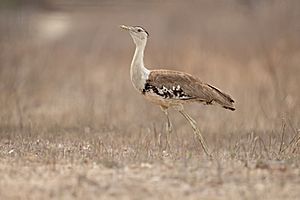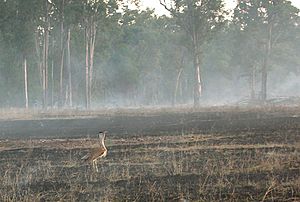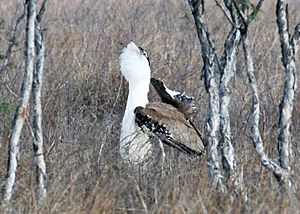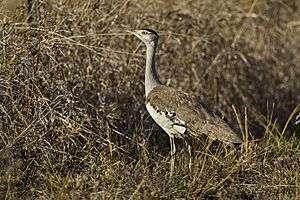Australian bustard facts for kids
Quick facts for kids Australian bustard |
|
|---|---|
 |
|
| Conservation status | |
| Scientific classification |
The Australian bustard (Ardeotis australis) is a large bird that lives on the ground. You can find it in grasslands, woodlands, and open farmlands across northern Australia and southern New Guinea.
This bird stands about one metre (around 3 feet) tall. Its wingspan is about twice that length. Australian bustards are nomadic birds. This means they travel long distances to find places where there is plenty of food. They used to be very common across Australia's open plains. However, their numbers dropped in areas where people settled during the colonisation of Australia.
The Australian bustard eats both plants and animals. They mostly enjoy fruits or seeds. But they also eat insects like crickets and grasshoppers. Sometimes, they even catch small mammals, birds, or reptiles.
People also call this bird the plains turkey. In Central Australia, Aboriginal people often call it the bush turkey. They sometimes hunt it for food. However, the name "bush turkey" can also refer to the Australian brushturkey or the orange-footed scrubfowl.
Contents
About the Australian Bustard
What is Taxonomy?
Taxonomy is how scientists name and group living things. The Australian bustard was first described by John Edward Gray in 1829. He gave it the name Otis australis. Later, in 1841, John Gould also described the bird.
Other Names for the Bird
The Australian bustard has many common names. These include bustard, plains turkey, wild turkey, and native turkey.
Indigenous Australians have their own names for this bird:
- The Arrernte name is kere artewe.
- The Luritja name is kipara.
- The Larrakia name is danimila.
- The Noongar peoples called it bebilya.
What Does the Australian Bustard Look Like?
The Australian bustard is the only type of Ardeotis bird found in Australia. This group of birds also lives in Africa and India. This bustard is a big ground bird. It looks and acts a bit like an American turkey. You can easily spot it because of its large size, long legs, and how it slowly walks across open plains.
The top of its head and back of its neck are black. The front of its long neck is light grey. Its wings and upper body are covered in brown feathers. Both male and female bustards look similar. However, females are smaller than males.
The belly of the bird is white. A black band of feathers separates the white belly from the light grey neck. Its wing feathers have patches of black and white. You can see this pattern when the bird is resting or flying. The bird's eyes are white, and its beak can be whitish or brown. Its long legs are yellow to cream colored.
Male bustards can be up to 1.2 metres (about 4 feet) tall. Their wingspan can reach 2.3 metres (about 7.5 feet). On average, males weigh about 6.3 kilograms (14 pounds). Females are quite a bit smaller. They are about 80 centimetres (31 inches) tall. Their wingspan is around 1.8 metres (6 feet). Females weigh about 3.2 kilograms (7 pounds) on average.
Even though it's the largest flying land bird in Australia, the Australian bustard is the smallest species in its group, Ardeotis.
How Do Australian Bustards Behave?
Australian bustards mostly stay on the ground. You usually see them walking slowly, either alone or in pairs. If something scares them, they often stand very still with their neck straight up and beak pointing to the sky. This helps them blend in. They might slowly walk away or run if they are very alarmed. Flying is usually their last choice. When they do fly, they take off with strong wing beats.
Young bustards that cannot fly will stay still if disturbed. Their mottled black and brown feathers help them hide. Even though flying looks like hard work for them, they are strong and can fly long distances. They usually rest in a high spot on an open plain or in trees if they are available.
Mating Displays
You might see more bustards during their breeding season. Usually, these birds are shy. But during breeding season, males put on a very noticeable show. They make loud booming sounds. The male can puff out a sac on its neck. This makes its longer feathers look like a swaying skirt. It holds its head up high, points its wings towards the ground, and arches its tail feathers over its back. While doing this, it walks around and makes deep roaring noises. The sound of the male's call is like "who-o-o-o".
Males might challenge each other using these displays and calls. But they rarely fight directly, unlike smaller bustard species.

Nests and Chicks
Australian bustards do not build nests. The female usually lays one egg, sometimes two. She lays them on the bare ground, often near a small shrub or bush. The egg is about 75 by 55 millimetres (3 by 2 inches). It has olive-brown blotches and streaks all over it. The background color is a lighter olive-brown or olive-green. The female takes care of incubating the egg.
Once the chick hatches, it leaves the spot quickly to avoid predators. Its mottled black and brown feathers help it hide. It stays still and relies on its camouflage to avoid being seen.
Sometimes, a bird called the black-breasted kite will try to get the bustard's egg. This kite is known to drop or throw stones to break the eggshell and eat the contents.
What They Eat
Australian bustards are very attracted to capers, which are fruits from a plant called Capparis nummularia. Indigenous peoples used this behavior to catch them. They would dig pit traps around the caper bushes and wait nearby.
Their diet includes seeds and fruits from plants. They also eat many different insects, especially grasshoppers. Lizards, young birds, and small rodents are also part of their omnivorous diet.
Where Do Australian Bustards Live?
Australian bustards live across a large part of Australia. They also sometimes appear in southern parts of Papua New Guinea and Indonesia. In southeastern Australia, their numbers have gone down, and they are no longer found in some areas where they once lived.
Scientists track these birds to learn about their movements. Birds in wetter areas tend to stay in one place more. Birds in drier areas travel over much larger distances. Australian bustards can become very numerous in an area after land is cleared or when there are many grasshoppers. They are most loyal to an area in the high rainfall regions of northern and northwestern Australia.
Australian bustards prefer open grasslands, sometimes with a few trees. They also like spinifex plains and low shrublands. They might go into thicker areas of plants after a fire. You can also see them in cleared areas made by humans, like golf courses and farms.
How Are Australian Bustards Protected?

The Australian bustard is still fairly common across most of northern Australia. However, their numbers have dropped in southeastern Australia over the last century. This might be because of hunting (which is now illegal for most people, except for Indigenous Australians), wild predators like pigs and foxes, and habitat destruction (when their living areas are destroyed).
These birds are very sensitive to being disturbed at their breeding sites by humans, cattle, or sheep. If disturbed, they might leave the area. Because they are nomadic, it's hard to count exactly how many there are. In 2012, the IUCN changed their status to "Least Concern." This means they are not currently at high risk of extinction.
In 2016, the IUCN kept their status as "Least Concern." But they noted that the population is slowly decreasing. The total number of Australian bustards is thought to be between 10,000 and 100,000 birds.
Protection in Different States
Different Australian states have their own rules for protecting the Australian bustard.
- In Western Australia and the Northern Territory, they are listed as "near threatened."
- In South Australia and New South Wales, they are listed as "endangered."
- In Queensland, they are listed as "least concern."
- In Victoria, the Australian bustard is listed as "critically endangered." This means they are at a very high risk of extinction in that state.
See also
 In Spanish: Avutarda australiana para niños
In Spanish: Avutarda australiana para niños
Images for kids






